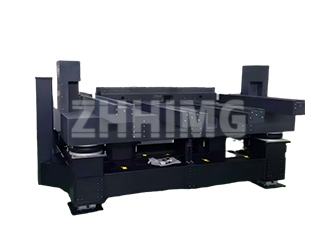The pursuit of absolute accuracy is fundamental to modern ultra-precision industries, where components must be verified against stringent standards. The runout gage, built upon a stable foundation of high-quality natural stone, is the cornerstone of verifying the concentricity and axial integrity of rotating parts. At ZHONGHUI Group (ZHHIMG®), we recognize that the instrument’s performance is intrinsically linked to the inherent superiority of its base material—our exclusive ZHHIMG® Black Granite—and the precision with which it is handled.
The physical properties of the granite base are the first line of defense against measurement error. Unlike common marble or lower-grade materials, our ZHHIMG® Black Granite is engineered for metrology, boasting an exceptional density of approximately 3100 kg/m³. This high density translates directly into superior stiffness and minimal thermal expansion, effectively stabilizing the measuring plane against environmental shifts. However, even with this robust foundation, the operating environment must mirror the instrument’s precision. Metrology labs typically mandate a strict temperature range of (20 ± 1)℃ and humidity between 40% and 60%. These controls mitigate the subtle dimensional changes that moisture absorption or temperature gradients can induce in even the most stable natural materials.
Preparation begins long before the first measurement is taken. The granite gage must rest on a rigid, vibration-isolated workbench—a practice we enforce within our own state-of-the-art 10,000 m² controlled environments, which feature specialized anti-vibration foundations. Prior to placing the workpiece, both the instrument and the component must be meticulously cleaned to remove any microscopic debris, oil, or dust. Contaminants not only cloud the reading but can damage the precision centers or the delicate stylus of the measuring indicator. Furthermore, selecting the correctly tapered centers ensures that the workpiece’s axis aligns perfectly and stably with the gage’s axis of rotation, minimizing geometric error from the outset.
The actual measuring sequence demands a blend of technical control and human delicacy. The precision indicator, often a high-resolution device calibrated to 0.5 μm (such as those from Mahr or Mitutoyo used in our own labs), must be mounted so its stylus contacts the measurement surface perpendicularly. The workpiece must then be rotated slowly and uniformly, maintaining constant, gentle contact with the stylus to avoid any backlash or lost motion in the indicator’s mechanism. The maximum swing recorded by the indicator represents the true runout error. To adhere to the highest standards of our quality policy—“The precision business can’t be too demanding”—we strongly recommend performing multiple, consistent measurements and averaging the results. This established statistical practice enhances the reliability of the final reported value, moving beyond a single reading to capture the component’s true dimensional characteristic.
Finally, the maintenance routine safeguards the long-term investment in precision. The granite surface and the precision steel components must be protected from physical shock and must never be overloaded beyond the instrument’s capacity. After use, all surfaces should be wiped clean with a soft, dry cloth. Critical metallic moving parts, such as the center cones and the indicator stand mechanism, require the application of a non-corrosive, light protective oil to prevent friction and corrosion. Storing the granite runout gage in a dedicated, dry, and stable environment, away from heavy objects or potential contaminants, is the final step in preserving the instrument’s geometric integrity for years of reliable, ultra-precision service.
Post time: Nov-17-2025

